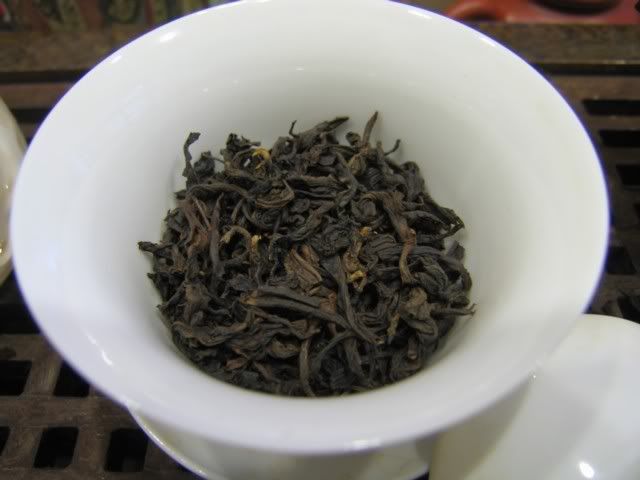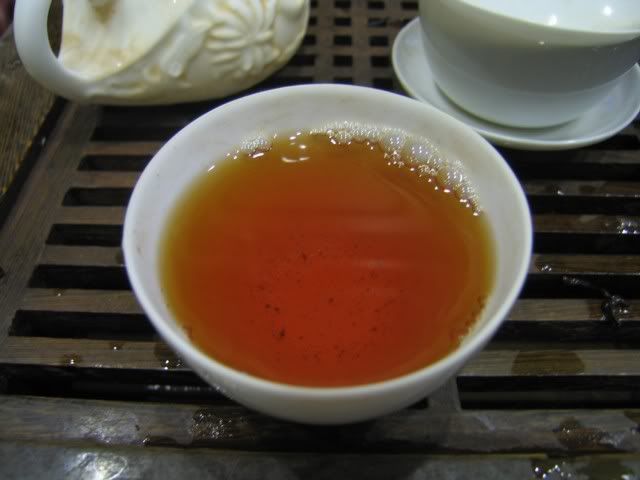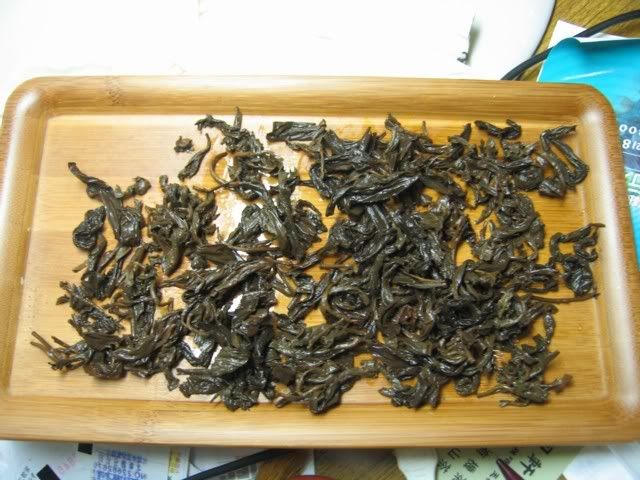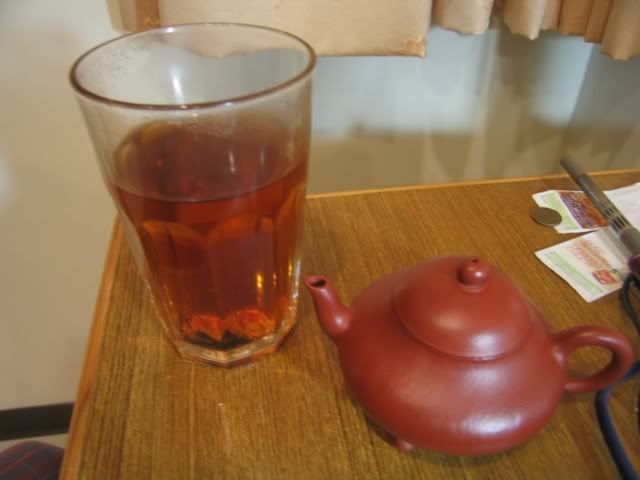How do you tell a good aged oolong from a bad one? After drinking a few months of this stuff, I at least have some tentative thoughts on this issue.
Let’s take today’s tea — a bag of tea I picked up yesterday in exchange for the bad aged oolong I got last time. I’ll get to why that one was bad later.

The dry leaves’ physical appearance will rarely tell you anything too useful. Colour of the leaves are almost always dark. Sometimes it’s darker than others, but that in and of itself is a very useless indicator of anything. The shape of the tea might tell you something about what it could be, but even then — not a very useful indicator.
The smell of the dry leaves, however, can. For teas that have turned somewhat sour, you can sometimes smell a sour note in the aroma of the dry leaves. If you want to cheat, you can always breath into a little leaves (that you of course placed in your hands and don’t really intend on throwing back into the bag). That way you can smell the aroma much more clearly. Sour? Give it up already, it’s not worth your time.
Assuming it passes the initial sourness test, then there are the teas that are musty or not musty. The ones that aren’t musty are often re-roasted, the ones that are musty, as I find over time, are usually less re-roasted or not at all. Makes sense — the roasting will kill any musty smell. Sometimes you can also smell the roasted nature of the tea from the dry leaves. Now, done with the dry leaves. Let’s move on to making the tea.

I usually fill the gaiwan with 1/2 to 2/3 full of leaves when I make this stuff, at least for a first try. Sometimes the sourness is subtle, and if you brew it with less leaves you don’t always notice the problem. Now, teas that don’t smell sour can still be a bit sour, but usually, those are sourness that go away in an infusion or two. That, personally, I find acceptable. I also find that teas that don’t taste sour at all when hot can sometimes take on more of a sour note when cooled a bit. That’s something to look out for.
For the really roasted stuff, you have to feel the body of the tea to see if it’s aged or not. Sometimes that charcoal taste masks a lot of things, including age. A highly roasted but not very aged tea will lack that nice sweet note at the end, and it will also be less thick, at least in my personal experience. Some of the really roasted stuff will need a bit of time to mellow out and let the charcoal taste go away a bit before drinking, but even for current consumption they can be good — if you are into that kind of thing. I don’t buy a lot of that stuff, but I do have some. It’s fun.
I personally like the less roasted stuff. They take on a puerh-like note the first few infusions, then mellow out into a sweet tea that will more closely resemble a young oolong. In the end you will get back the young oolong taste/finish without much aged note at all other than the extra sweetness. It’s very interesting that way. Even aged and somewhat roasted stuff can do this. The tea that I originally wanted from the store is exactly like this — the first few infusions taste almost like a liu’an, and then into a softer, sweeter aged oolong taste, and then ending up as a younger tea would taste. I like this kind of tea the best. Today’s tea is sort of like that — I felt almost like I was drinking a new oolong near the end, without the harshness of a young tea. Also, aged oolongs tend to go on forever. You should be able to get 10+ steepings from it easily.

Wet leaves says a lot about what you’re drinking. In fact, I think wet leaves tell you more about what you’re drinking than anything else other than the physical act of drinking the tea. It will confirm what kind of tea you’re actually drinking, usually, and it will also tell you the condition of the tea, whether it’s mixed or not, etc, things that aren’t always apparent in a cup but usually more apparent when you can spread out the leaves. Today’s tea hasn’t been reroasted much — that much is obvious. The leaves unfurl easily, with a greenish scent. Decent tea.
So, what was the tea that I rejected like? It was roasted — tastes like charcoal the first infusion. But the body of the tea was thin and died fast. It was not aged, or not much aged. I’d venture to guess it’s less than 5 years old, which is why I was so unhappy about it.





 RSS - Posts
RSS - Posts
I took you at your suggestion and have been reading some of your old post-Covid posts. I haven’t been to…